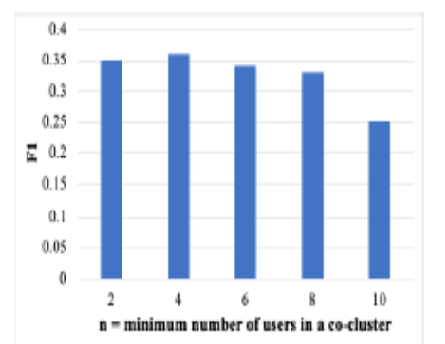


Indian Journal of Science and Technology
Year: 2023, Volume: 16, Issue: 29, Pages: 2204-2216
Original Article
Shipra Kataria1*, Usha Batra2
1PhD Scholar, Department of Computer Science and Engineering, GD Goenka University, Gurugram, India
2Professor, Department of Computer Science and Engineering, GD Goenka University, Gurugram, India
*Corresponding Author
Email: [email protected]
Received Date:15 March 2022, Accepted Date:25 April 2022, Published Date:03 August 2023
Objectives: To implement Nearest Co-cluster Collaborative Filtering (NCCF) using a novel similarity index and evaluate its performance in sparse environments. Methods: An experimental and comparative evaluation of the proposed technique is performed using Python’s built – in data analysis packages. As a preliminary step, preprocessing is performed on the explicit book – crossing rating dataset acquired from the GroupLens research lab database. After preprocessing, the nearest co-cluster algorithm based on a novel similarity index is applied to achieve partial matching of users’ preferences. The proposed nearest co-cluster algorithm is experimented against two distinct types of co-clustering algorithms: Bimax for constant coclustering (abbreviated as NCCF – B) and xMotif for coherent co-clustering (abbreviated as NCCF – X). In addition, a co-clustering package CoClust and the toolkit BIDEAL are utilized for co-clusters visualization. Findings: Extensive performance evaluation findings of the proposed technique are provided, and the technique has been found to be promising for generating pertinent recommendations despite data sparsity. The technique can significantly reveal the dualism between users and books through co-clustering and partial matching of users’ preferences. Compared in terms of precision, recall, and F1 score, NCCF – B and NCCF - X outperformed Item – Based CF (IBCF), User – Based CF (UBCF) and Clustering – Based CF (CBCF). NCCF – B and NCCF – X outperformed with a precision difference of over 30% and a recall difference of 10%. When comparing two co-clustering algorithms, NCCF – X outperformed NCCF – B slightly but consistently. The differences in precision and recall are approximately 3% and 2%, respectively. However, the CBCF technique outperformed the other considered techniques in terms of execution time. Novelty : NCCF is robust in sparse environments due to its ability in revealing the dualism between users and books and in capturing the partial matching of users’ preferences.
Keywords: Recommender System; Collaborative Filtering; Similarity Index; CoClustering; Nearest Neighbor
© 2023 Kataria & Batra. This is an open-access article distributed under the terms of the Creative Commons Attribution License, which permits unrestricted use, distribution, and reproduction in any medium, provided the original author and source are credited. Published By Indian Society for Education and Environment (iSee)
Subscribe now for latest articles and news.